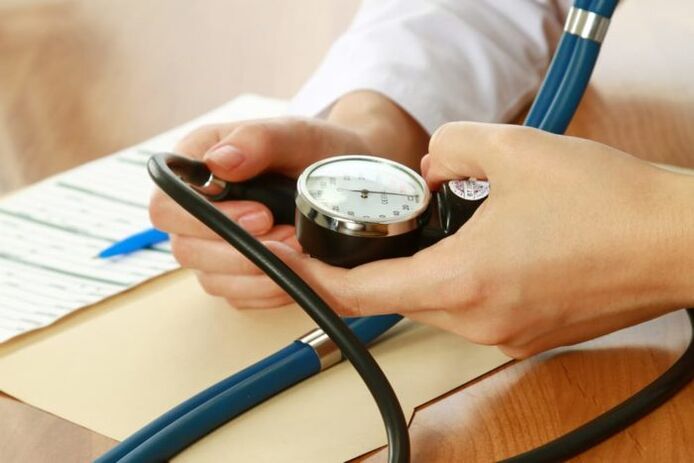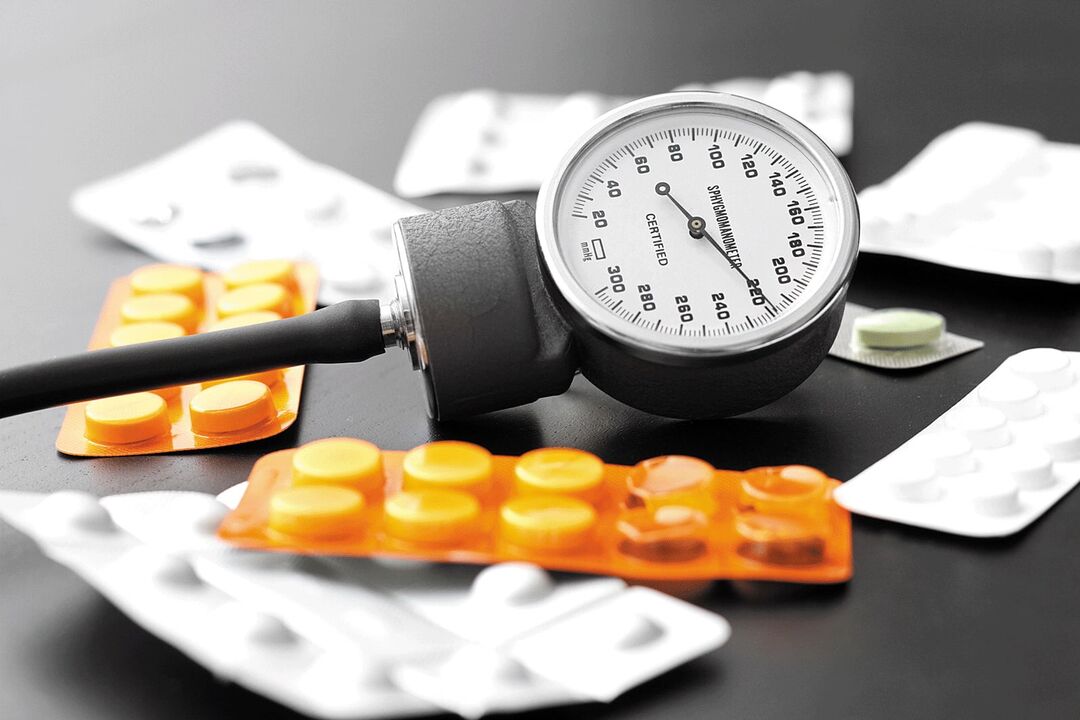The diagnosis of hypertension is suspected only when blood pressure is persistently elevated in the face, or frequently jumps. At the same time, the different stages of hypertension manifest themselves with different intensities. In the early stages of the disease, people are often unaware of the development of problems. Sometimes, even a slight increase in temperature is more noticeable than a violation of the condition when arterial hypertension develops. Pathologies differ in the degree of manifestation of symptoms and the presence of concomitant disorders in the body. In fact, even if there are no obvious signs, high blood pressure is equally dangerous when adding many disruptive substances in the body. Signs of high blood pressure include: trembling limbs, nausea, headache, flies flying in front of the eyes. All symptoms develop due to problems with blood flow to internal organs.

Stages of hypertension
Clinic of hypertension, based on the effect on the whole body and the strength of accompanying symptoms, is classified into stage and severity. There are 3 stages. The division into stages helps the physician to systematize the obtained diagnostic data and select the appropriate tactics to correct the patient's condition.
1 stage
The blood pressure level in stage 1 of hypertension does not exceed 159/99. This increase can last for several days. Rest will help normalize blood pressure, eliminate stress. With further progression of the pathology, it will not be so easy to restore the rated pressure.
At this advanced stage of the disease, there is no indication that it affects target organs. For this reason, arterial hypertension is often asymptomatic. Only when sleep is disturbed can latent pains in the head and heart develop.
When conducting clinical diagnosis, it is possible to establish a slight increase in the sound of the muscular arteries. In the early stages of the disease, the risk of developing high blood pressure is very small, often this condition occurs only due to the influence of external circumstances on the body. The risk also increases in women during menopause. The early stage responds well to treatment. For this, lifestyle changes are usually enough. Medicines are not always needed. With timely treatment and strict observance of the doctor's instructions, the prognosis is favorable.
2 stages
This is the period of active pathological changes in the pulse - severe hypertension. The pressure in stage 2 reaches 179/109. Rest does not restore its level. One person complains of severe headaches, shortness of breath on exertion, trouble sleeping, dizziness, and increased heart rate.
This stage is characterized by the development of the first signs from the internal organs. The most common symptoms of severe hypertension are:
- signs of left ventricular hypertrophy;
- narrowing of the lumen of the retina;
- increased cholesterol in the blood;
- presence of protein in the urine.
Stage 2 hypertension significantly increases the risk of dangerous complications that can lead to stroke. Without continuous medical treatment, it will not work.
3 stages
This is a stage of target organ dysfunction due to pathological changes in the arteries and impaired blood flow throughout the body. Stage 3 hypertension is very severe. The final stage of hypertension is the most severe stage, widespread disorders develop in the body, affecting the target organs. The eyes, kidneys, brain and heart are most affected. The pressure in stage 3 has stabilized, even with drug treatment, it is difficult to normalize. There are usually jumps up to 180/110 mm Hg. Art. and even more. Symptoms are similar to those of stage 2, but in addition it is accompanied by pathological manifestations from the affected organs. Memory is often poor, heart rate is greatly disturbed, vision is reduced.
This stage is dangerous because it always affects the heart. Its contractility and impulse conduction in the myocardium are disturbed.
Degree
With an increase in blood pressure and no effect of the measures taken, it can be assumed that the disease is progressing. The optimal blood pressure level is 120/80. The norm for systolic blood pressure is between 120 and 129, and diastolic between 80 and 84. There is also a normal high pressure when a person feels fine - up to 139/89 mm Hg. Art. In medicine, hypertension is classified into 3 degrees.
I have a degree
Grade 1 arterial hypertension is mild, characterized by reduced pressure and ranges from 140/90 to 159/99. The risk of a crisis in this situation is minimized, there are no symptoms of dysfunction of other organs and central organs. nerve system. To suppress an attack, in addition to taking specific medications, you need to relax a bit, try to avoid stress, go for a walk and positive emotions have good effects on health.

If the systolic blood pressure does not exceed 159, and the diastolic - 99 mm Hg. Art. , The person was then diagnosed with mild-first-degree hypertension. It is characterized by such signs:
- headaches that get worse with exertion;
- sharp, stabbing pain on the left side in the chest, spreading to the shoulder blades and under the arms;
- dizziness so severe that it may lead to fainting;
- acceleration of heart rate;
- black flies;
- Tinnitus;
- sleep disorders.
A person will not notice the symptoms listed if they develop continuously. A hypertensive crisis can begin under the influence of stress, and with appropriate support, the hypertensive crisis will pass without consequences.
Degree II
Grade 2 hypertension begins to develop more actively. The pressure level has reached 160/100 - 179/109. Signs of a hypertensive crisis develop - cold sweats appear, goosebumps appear, the skin on the face turns red.
Symptoms of grade 2 disease include:
- transient cerebral ischemia - impaired blood flow to the organ;
- an increase in the concentration of creatinine in the blood;
- narrowing of the arteries in the retina;
- an increase in the size of the left ventricle;
- protein in the urine, found during tests;
- persistent fatigue;
- nausea;
- pulse in the head;
- facial swelling;
- severe sweating;
- damage to internal organs;
- numbness of the fingers;
- blurry vision;
- crisis.
The drug does not cope well with the normalization of the patient's condition. Doctors pay attention not only to the level of pressure, but also to the rate at which the disease develops. Second-degree hypertension affects the kidneys. Patients almost always complain of discomfort.
Grade III
Grade 3 hypertension is the most severe. When it happens, vision is drastically reduced, memory is poor, tachycardia is common, and there is a high risk of developing high blood pressure. Complications of this condition include blood clots, encephalopathy, aneurysms, kidney failure and the left ventricle of the heart, formation of bruises throughout the body, and swelling of the optic nerve. The pathology is irreversible. With grade 3 hypertension, the patient necessarily needs outside help and care. The main signs of high blood pressure are:
- arrhythmia;
- unsteady gait;
- significant visual impairment;
- violation of blood flow in the brain, causing paralysis and paralysis;
- crisis, accompanied by confusion and speech impairment;
- heart ache;
- bleeding;
- limited mobility and self-service capabilities;
- inability to communicate properly.
These symptoms indicate progression of hypertension and new organ involvement in the disease. Gradually, many irreversible complications develop.
Classification according to risk factors
Hypertension is, first of all, dangerous with many complications and often irreversible. Most patients become disabled or die not specifically from high blood pressure, but from the acute disorders in other organs it causes.
The most dangerous conditions are ischemic necrosis, cerebral hemorrhage, myocardial infarction, renal failure. To prevent various complications related to dysfunction of other organs, the doctor determines the level of risk during the examination. The risk levels are represented by the numbers 1 to 4. It turns out that the diagnosis contains information about the extent and risk of damage, for example, GB level 2, risk 4.
Low risk (negligible)
This indicator of risk of developing complications of hypertension was observed in women under 65 years of age and in men under 55 years of age with mild stage 1 hypertension. Over the next 10 years, only 15%Some people develop additional heart and vascular disorders as a result of high blood pressure. These patients are often seen by general practitioners, as it makes no sense to go to a cardiologist and take the treatment seriously.
When minor risks persist, a person needs lifestyle changes for the next 6 months. This will lead to positive developments. If there are no results and no reduction in blood pressure is possible, then the patient management strategy should be changed and pharmacological therapy instituted.
Medium risk
This group of patients includes hypertensive patients, whose blood pressure readings are no more than 179/110. As a rule, these people have 1 - 2 of the following risk factors:
- smoke;
- genetics;
- fat;
- high cholesterol levels;
- lack of physical activity;
- impaired glucose tolerance.
In the next 10 years, 20% of cases will have dangerous cardiovascular diseases. Organizing a reasonable lifestyle is an integral part of maintaining health. For 3-6 months, medication may not be indicated for maximum recovery through lifestyle changes.
high risk
This risk group includes patients with an index of 179/110 or higher in the presence of more than 2 risk factors. In addition, people with target organ damage, diabetes, retinal vascular disorders, and atherosclerosis are at increased risk.
There may also be no risk factors, but someone with stage 3 hypertension is at high risk anyway. They must be treated by a cardiologist. The risk of complications is 30%. Lifestyle normalization is used only as an additional tactic against the use of specially selected drugs. The selection of the most effective drugs should be carried out as soon as possible.
Treatments
The primary goals of hypertension treatment are to reduce the pressure and prevent its consequences. Complete recovery is not possible, but adequate and staged treatment helps to prevent active progression of the disease and reduce the risk of hypertension.
Drug treatment usually includes the use of antihypertensive drugs that inhibit the production of norepinephrine and its vasopressor activity. At the same time, it is necessary to appoint diuretics, antiplatelet agents, hypoglycemic agents, hyponatremic drugs and sedatives. In the absence of the expected result, the combined effect of several antihypertensive drugs is carried out at the same time.
During a hypertensive crisis, it is necessary to reduce the pressure within an hour of the attack, otherwise the risk of serious complications and death is increased. In such a situation, antihypertensive drugs are used by injection or drip.

Regardless of the degree and stage of dysfunction of the body, an important method of treatment is the normalization of nutrition, adherence to a special diet. The diet necessarily includes foods rich in magnesium, potassium, vitamins. It is necessary to limit the use of salt, avoid alcohol, fried foods with a lot of fat. With obesity, the daily calorie content of the diet is reduced, sugar, cakes and other confectionery products are prohibited.
People with hypertension benefit from moderate physical activity - exercise therapy, swimming, walking. Massage therapy also has a good effect on the health of hypertensive patients. Smoking is strictly prohibited, you should develop resistance to stress with the help of psychotherapeutic methods and relaxation techniques.
The effectiveness of complex therapy is evaluated according to several criteria:
- The short-term goal is to normalize pressure to a level where the patient feels well.
- The medium-term goal is to prevent the emergence and aggressive development of pathologies in the target organs.
- The long-term goal is to prevent complications and prolong survival.
Hypertension is a disease that is easier to prevent than to fight with it for the rest of your life, trying to alleviate symptoms and prevent the condition from getting worse systematically. The earlier the diagnosis and stage of hypertension, the more effective the treatment.





























